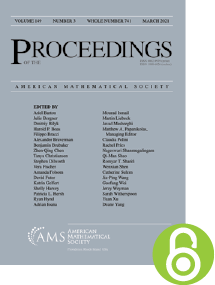Note on nonnegative matrices
Author:
D. Ž. Djoković
Journal:
Proc. Amer. Math. Soc. 25 (1970), 80-82
MSC:
Primary 15.60; Secondary 65.00
DOI:
https://doi.org/10.1090/S0002-9939-1970-0257114-X
MathSciNet review:
0257114
Full-text PDF Free Access
Abstract | References | Similar Articles | Additional Information
Abstract: Let $A$ be a nonnegative square matrix and $B = {D_1}A{D_2}$ where ${D_1}$ and ${D_2}$ are diagonal matrices with positive diagonal entries. Several proofs are known for the following theorem: If $A$ is fully indecomposable then ${D_1}$ and ${D_2}$ can be chosen so that $B$ is doubly stochastic. Moreover, ${D_1}$ and ${D_2}$ are unique up to a scalar factor. It is shown that these results can be easily obtained by considering a minimum of a certain rational function of several variables.
- Richard A. Brualdi, Seymour V. Parter, and Hans Schneider, The diagonal equivalence of a nonnegative matrix to a stochastic matrix, J. Math. Anal. Appl. 16 (1966), 31–50. MR 206019, DOI https://doi.org/10.1016/0022-247X%2866%2990184-3
- M. V. Menon, Reduction of a matrix with positive elements to a doubly stochastic matrix, Proc. Amer. Math. Soc. 18 (1967), 244–247. MR 215873, DOI https://doi.org/10.1090/S0002-9939-1967-0215873-6
- Richard Sinkhorn, A relationship between arbitrary positive matrices and doubly stochastic matrices, Ann. Math. Statist. 35 (1964), 876–879. MR 161868, DOI https://doi.org/10.1214/aoms/1177703591
- Richard Sinkhorn and Paul Knopp, Concerning nonnegative matrices and doubly stochastic matrices, Pacific J. Math. 21 (1967), 343–348. MR 210731
Retrieve articles in Proceedings of the American Mathematical Society with MSC: 15.60, 65.00
Retrieve articles in all journals with MSC: 15.60, 65.00
Additional Information
Keywords:
Nonnegative matrix,
doubly stochastic matrix,
irreducible matrix,
fully indecomposable matrix
Article copyright:
© Copyright 1970
American Mathematical Society



